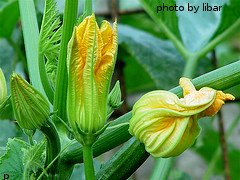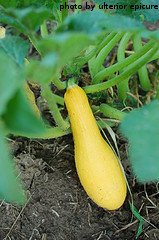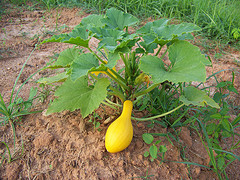Summer Squash Diseases
Lots of backyard vegetable gardeners have problems with summer squash diseases. Most of these problems are insect related. It's important to try and prevent the pests from invading your summer squash plants. Once the plants are infested, it may be too late to save your plants and all your hard work will have gone to waste.
Most summer squash diseases are caused by three main insects:
- Cucumber Beetles
- Vine Borers
- Squash Bugs
The most common summer squash problems are caused by cucumber beetles. The striped cucumber beetle has black and yellow spots on its back. The spotted cucumber beetle has a yellow back with black spots. They love to chew on young summer squash leaves and stems. Cucumber beetles also carry wilt diseases from plant to plant. Fortunately, these pests can be controlled with common insecticides including sprays and dust. Diazinon and Malathion are common chemicals that will kill cucumber beetles. Apply products that contain these pesticides according to the manufacturer's instructions. Most can be applied soon after the seedlings emerge and throughout the growing season. Organic products including soap sprays are also available at most garden centers.

Vine borers are a common garden pest and can do some serious damage. They will attack any summer or winter squash plant, along with cucumbers and pumpkins. They will bore into the main stems at the base of your summer squash plants, sucking out the juices and eating the plants themselves. Once inside the stems, they will continue eating away at your plants from the inside out. Many times this damage is not noticed until significant and irreversible damage has already been done. The squash growth will suddenly slow and the plant will wilt, shrivel and die. Many backyard vegetable gardeners see the plant wilting and assume that the problem is lack of water. If the plants continue to wilt after a thorough soaking, you're definitely battling vine borers. You will also notice something that resembles a small pile of sawdust at the base of your plants. There are several products on the market that will prevent vine borer infestation. It's important to apply these products before your summer squash plants become infested. Read the labels on products that contain Diazinon to make sure that the spray is effective against squash vine borers. Follow the manufacturers directions. Most of these insecticides can be applied soon after the seedlings first emerge. Once the plants stay consistently wilted, you've probably lost the battle. At this point, it's best to pull the plants out of the garden and start over by planting more seeds.

Squash bugs can cause plenty of summer squash diseases. They are usually gray or brown in color, although some are almost black. They are usually about the size of a dime and travel in packs. Squash bugs will suck the juices from the plant and will actually attack the squash itself, although they usually lay their eggs on the underside of the leaves. Again, it's easier to prevent a squash bug problem than cure it. Many of the same products that prevent vine borers and cucumber beetles will also prevent squash bug infestations. You can begin spraying soon after the seedlings emerge. By the time the blossoms appear and the plants begin to set fruit, you should have the problem under control. Most of these insecticides are available at most garden centers and should be applied according to the manufacturer's instructions. If you are trying to grow organically, choose pest resistant summer squash varieties and keep your garden free of weeds and other plant debris. You can also cover the stems of the plants with cardboard tubes to discourage pests.
We've had good results in our own garden with a homemade soap spray. We mix together 2 gallons water, 4 tablespoons liquid dish soap and 4 tablespoons hot sauce in a 2 gallon pressure sprayer. We shake it up and spray it all over our summer squash plant every 10 days or so or after every heavy rainfall. This mixture won't kill any pests, but it does encourage them to move elsewhere and works well as a preventative measure.
Summer squash plants are also susceptible to diseases including wilt disease, powdery mildew, downy mildew and scab disease. If these diseases have affected your summer squash plants, you will notice discolored leaves with splotches on them. Most summer squash diseases are controlled by choosing disease resistant plant varieties. They can also be controlled with soap sprays and/or fungicides that are readily available in most garden centers.
We've implemented a preventative fungicide spray program in our own garden with good results. We mix together 2 gallons water, 4 tablespoons baking soda and 4 tablespoons hydrogen peroxide in a 2 gallon pressure sprayer. We shake it up and spray it all over our summer squash plants every 10 days or so, or after every heavy rainfall. If we still end up with a fungal infection, we switch to a commercial fungicide product.
Remember, when dealing with most garden pests and diseases, "an ounce of prevention is worth a pound of cure". We hope these tips will help you to avoid most summer squash diseases.
Click on the following links to learn more about growing summer squash.

Click here to learn about planting summer squash
Click here to learn about watering and fertilizing summer squash plants
Click here for information about harvesting summer squash
Click here for some of our favorite summer squash recipes
Click here to learn about different summer squash varieties
Click here to move from our Summer Squash Diseases page to our Growing Summer Squash main page
Click here to return to our Home page